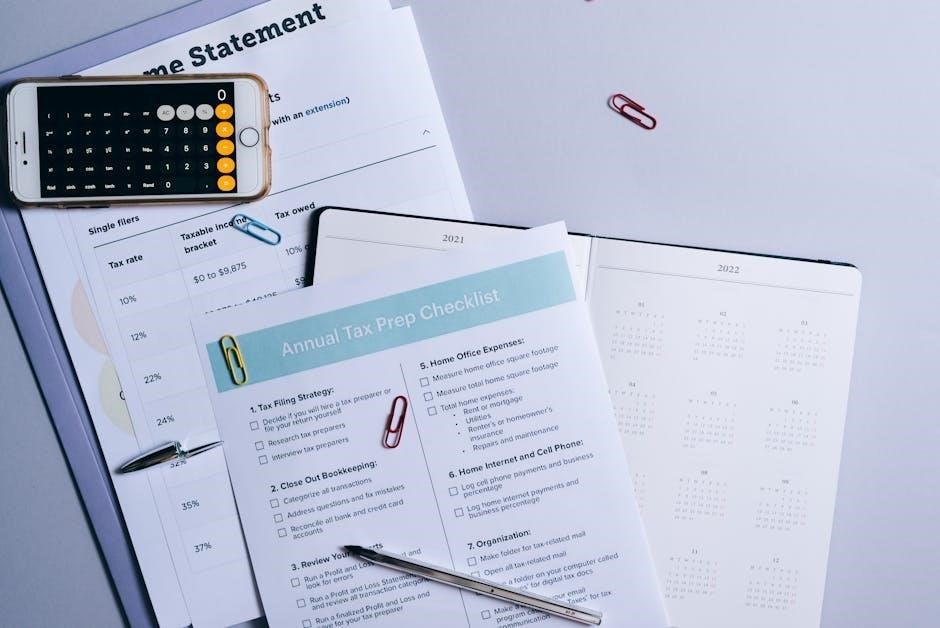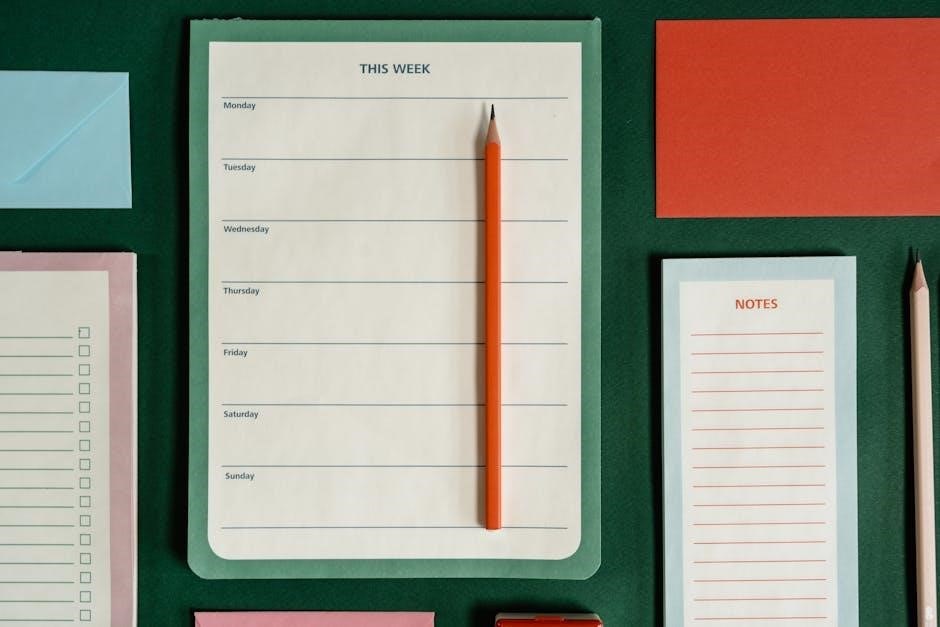Planning a wedding in six months is achievable with a detailed checklist and timeline, ensuring organization and stress-free preparation for your special day.
1.1 Importance of a 6-Month Checklist
A 6-month wedding checklist is essential for ensuring every detail is organized and completed on time. It helps break down tasks into manageable steps, prevents last-minute stress, and keeps you focused on priorities. By setting clear deadlines, you can avoid overwhelm and ensure a smooth journey to your wedding day. A checklist also acts as a visual reminder, making it easier to track progress and stay accountable throughout the planning process.
1.2 Benefits of Using a Printable PDF Checklist
A printable PDF checklist offers a practical and organized way to manage wedding planning. It allows you to track progress visually, set deadlines, and ensure no tasks are overlooked. The satisfaction of checking off completed items helps maintain motivation. PDF formats are easy to share with partners or vendors, and having a physical copy provides a reliable backup. This tool simplifies planning and keeps everything accessible in one place.
Setting the Foundation
Setting the foundation involves determining your budget, prioritizing needs, and creating a detailed guest list. These steps ensure a clear roadmap for your wedding planning journey.
2.1 Determining the Budget and Priorities
Determining your budget and priorities is the first step in setting the foundation for your wedding planning. Start by allocating funds to key areas like venue, catering, and photography. Assess what matters most to you and your partner, whether it’s the guest experience or a luxurious venue. Prioritize needs over wants to ensure a balanced and realistic budget. This step helps guide decisions and keeps planning focused and manageable.
2.2 Creating a Guest List
Creating a guest list is a crucial step in the planning process. Start by compiling names and contact information, considering close family, friends, and colleagues. Categorize guests into “must-invite,” “should-invite,” and “could-invite” groups to help finalize numbers. Share the list with your partner and vendors to ensure everyone is on the same page. Finalize and stick to your total to avoid overspending and logistical challenges.
Venue and Date Selection
Securing a venue and finalizing the date is a cornerstone of wedding planning. Research and book a venue early, as popular locations fill quickly, then set your official wedding date to guide all other arrangements.
3.1 Researching and Booking the Venue
Start by researching potential venues that align with your vision, budget, and guest count. Consider factors like location, availability, and amenities. Consider factors like location, availability, and amenities. Create a shortlist and schedule tours to evaluate spaces. Once satisfied, book the venue promptly to secure your date, ensuring all details are outlined in the contract. This step is crucial for setting the foundation of your wedding plans.
3.2 Finalizing the Wedding Date
Once the venue is booked, finalize your wedding date, ensuring it aligns with your vision and guest availability. Consider factors like seasonal preferences, personal significance, and vendor availability. Confirm the date with all vendors and create a contingency plan for unexpected changes. Finalizing the date early allows you to move forward with other planning aspects, setting a clear timeline for your special day.
Wedding Party and Attire
Selecting and organizing the wedding party, including bridesmaids and groomsmen, is crucial. Manage attire orders and fittings efficiently to ensure everyone looks perfect on the big day.
4.1 Selecting Bridesmaids and Groomsmen
Selecting your wedding party involves choosing trusted friends and family to stand by your side. Consider relationships, reliability, and compatibility. Discuss expectations, roles, and availability early to ensure everyone is committed. Finalize your list within the first month of planning to allow time for attire fittings and coordination. Their support will make your wedding journey memorable and stress-free.
4.2 Ordering Bridesmaids and Groomsmen Attire
Order bridesmaids’ and groomsmen’s attire early to ensure timely delivery. Schedule fittings to confirm sizes and styles. Finalize orders 4-5 months before the wedding to avoid delays. Coordinate colors and designs with your wedding theme. Ensure alterations are booked if needed. Communicate deadlines clearly with your wedding party to guarantee everyone is dressed and ready for the big day.

Ceremony and Reception Planning
Organize the ceremony and reception details, ensuring a smooth flow between events. Plan seating, decor, and timing to create a cohesive and memorable experience for all guests.
5.1 Deciding on Ceremony Type and Officiant
Choose a ceremony type that reflects your style and beliefs, whether religious, civil, or non-traditional. Research and book an officiant early, ensuring they align with your vision and legal requirements. Confirm their availability and review the ceremony structure to ensure a meaningful and personalized experience for you and your guests.
5.2 Planning the Reception Layout
Decide on the reception layout, considering seating arrangements, table settings, and overall aesthetic. Choose between round, long, or sweetheart tables. Ensure space for the dance floor, buffet, or bars. Consider flow for guest movement and accessibility. Finalize details like centerpieces, linens, and lighting to create a cohesive and inviting atmosphere that reflects your wedding theme.
Vendor Bookings
Research and book reliable vendors, including photographers, videographers, caterers, and florists. Ensure they align with your vision and budget. Popular vendors often book quickly, so act promptly.
6.1 Hiring a Photographer and Videographer
Hiring a photographer and videographer is crucial for capturing your wedding memories. Research professionals, compare portfolios, and check availability. Ensure their style aligns with your vision. Book early to secure your favorites, as popular vendors fill up quickly. Discuss your preferences and create a shot list to ensure all key moments are covered. A good photographer and videographer will make your memories last a lifetime.
6.2 Booking a Caterer and Florist
Booking a caterer and florist is essential for enhancing your wedding experience. Research reputable vendors, schedule tastings, and discuss menu preferences. For florists, share your vision and budget to create stunning arrangements. Ensure both vendors are available on your wedding date and confirm all details in writing to avoid last-minute issues. Their contributions will significantly impact the ambiance and guest experience.
Wedding Dress and Attire
Finding the perfect wedding dress and coordinating attire for the wedding party is a highlight of the planning process, ensuring everyone looks stunning on the big day.
7.1 Finding and Purchasing the Wedding Dress
Finding the perfect wedding dress is a pivotal moment in the planning process. Start by researching styles, fabrics, and designers that align with your vision and budget. Schedule dress fittings at bridal salons, allowing time to explore various looks. Consider the wedding venue, theme, and season when selecting the dress. Once you find “the one,” purchase it and book alterations to ensure a flawless fit. This step is crucial for feeling confident and beautiful on your special day.
7.2 Scheduling Dress Alterations
Scheduling dress alterations is essential to ensure a perfect fit. Book your first fitting 2-3 months before the wedding, with follow-ups as needed. Most brides require 2-3 fittings to achieve the desired look. Discuss timelines and costs with your seamstress early to avoid delays. Final alterations should be completed 1-2 months prior to the wedding, allowing time for last-minute tweaks. Proper planning ensures your dress is flawless for the big day.

Wedding Website and Invitations
Creating a wedding website and designing invitations are key steps. Launch your website 3-4 months prior to share details and manage RSVPs. Send invitations 2-3 months before the wedding.
8.1 Creating a Wedding Website
Creating a wedding website is essential for sharing event details, accommodations, and registry information. Choose a domain name, select a design, and include key sections like ceremony details, directions, and RSVP options. Launch your website 3-4 months before the wedding to keep guests informed and engaged. Ensure it’s mobile-friendly and easy to navigate for seamless communication.
8.2 Designing and Sending Invitations
Design your wedding invitations to reflect your theme and style. Include essential details like date, venue, dress code, and RSVP information. Send them 2-3 months before the wedding to give guests ample time to respond. Consider digital invites for convenience, but traditional paper invitations remain popular for their elegance. Ensure accuracy in wording and mailing addresses to avoid delays or mistakes.

Ceremony and Reception Details
Plan ceremony readings, select music, and finalize the menu. Coordinate with vendors for decor and timing. Ensure all details align with your theme and style. Create a detailed timeline for a seamless flow of events.
9.1 Planning Ceremony Readings and Music
Select meaningful readings and choose music that reflects your style. Coordinate with the officiant to ensure smooth delivery. Finalize the playlist for pre-ceremony, procession, and recession. Ensure all audio equipment is tested. Assign a trusted person to manage the music and readings during the ceremony for a flawless execution of your special moments.
9.2 Finalizing the Wedding Menu
Decide on the number of courses and select dishes that align with your theme and preferences. Schedule a tasting with your caterer to confirm flavors and presentation. Consider dietary restrictions and special requests. Finalize the menu layout and design. Coordinate with your venue and designer to ensure the menu complements the overall aesthetic. Confirm timing for food preparation and service.

Final Countdown
Confirm vendor details, finalize seating arrangements, and ensure all logistics are in place. Prepare an emergency kit and review the timeline for the big day.
10.1 Confirming Vendor Details
Reach out to all vendors to confirm arrival times, deliveries, and setup details. Review contracts to ensure all services align with your expectations. Create a master list of vendor contacts and share it with your wedding party. Ensure all payments are finalized and receipts are collected. This step ensures a smooth execution of your wedding day plan.
10.2 Preparing for the Wedding Day
Finalize seating arrangements and confirm the wedding day timeline with vendors. Pack essentials like attire, accessories, and emergency items. Complete last-minute tasks such as makeup trials or rehearsal attendance. Ensure all items are ready for the ceremony and reception. Review the schedule with the wedding party to ensure everyone knows their roles. Rest and stay calm to enjoy the celebration of your special day.
